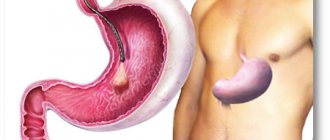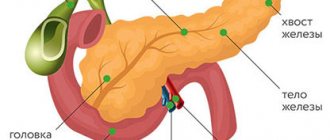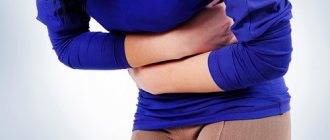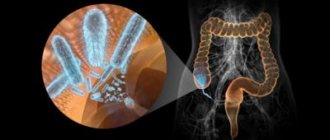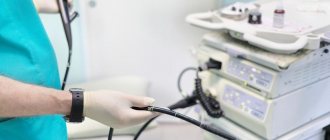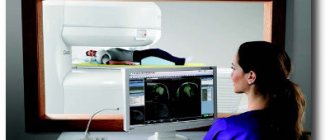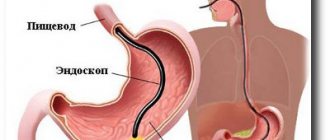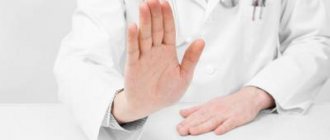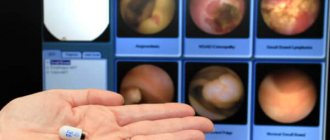FGDS, or gastroscopy, or fibrogastroscopy, or fibrogastroduodenoscopy is a highly informative research method that allows you to assess the condition of the mucous membrane of the esophagus, stomach and duodenum by using a probe equipped with a video camera and a light source. Surely the reader has come across this procedure and, if he has not gone through it himself, then he has heard about it from friends and acquaintances. From our article you will learn about the indications and contraindications for FGDS, how to prepare for it and the methodology for carrying out this procedure.
What will a gastroscope “show”?
FGDS is rightly called the leading method for diagnosing diseases of the upper digestive tract - the esophagus, stomach and duodenum. It will show the specialist who performs it a complete, and most importantly, reliable picture of the condition of the gastric mucosa, help make a final diagnosis, take a tissue sample for subsequent microscopic examination, and sometimes perform some therapeutic manipulations - stop bleeding or remove a tumor.
- The flexible gastroscope tube and advanced optical system allow the doctor to carefully examine the mucous membrane of the above organs, and if necessary, take a photo of it or videotape the examination process. Thus, existing damage to the mucosa will be detected, their size, depth and nature will be assessed.
- If a patient is diagnosed with gastrointestinal bleeding, gastroscopy will make it possible to determine its cause and even eliminate it.
- If the patient is undergoing treatment for a peptic ulcer, FGDS will help evaluate its effectiveness - by doing a gastroscopy before and after the start of therapy, the doctor will compare how the ulcerative defect on the mucous membrane has changed and whether it is necessary to continue treatment.
- If a benign neoplasm is detected in the stomach, by repeating FGDS over time, the doctor can track how the tumor behaves - whether it is growing or not, whether it is degenerating into a malignant one.
Gastroscopy results
During gastroscopy, it is possible to confirm or refute the diagnosis of esophagitis, peptic ulcer of the esophagus and functional diseases, as well as make a diagnosis of gastritis, gastric ulcer, polyps and other diseases.
In emergency situations, gastroscopy is a simple and easy way to stop bleeding from gastric vessels during peptic ulcer disease and further monitor the cure.
Compared to other methods (x-ray), gastroscopy has the advantage of being more informative, less invasive, and lacking radiation exposure.
The method has been widely used for decades and helps in the effective diagnosis and treatment of problems of the esophagus and stomach.
Indications for gastroscopy
can be very diverse. This is due to the fact that this endoscopic procedure is informative, quick and allows for a visual inspection of the upper part of the esophagus (esophagus, stomach and duodenum) using a thin, flexible tube, inside of which a fiber-optic system is located.
Over time, thanks to the implementation of innovative solutions, it became possible to use gastrocopes not only as a diagnostic method. Today they can be used for biopsies, as well as as a therapeutic method for the development of certain gastrointestinal diseases. Although previously such problems were solved only surgically.
Gastroscopy: indications
The doctor recommends that the patient undergo FGDS as planned if he suspects one or more of the following diseases:
- esophagitis;
- varicose veins of the esophagus;
- esophageal diverticula;
- obstruction of the esophagus and/or stomach;
- peptic ulcer of the stomach and duodenum;
- chronic gastritis, duodenitis;
- malignant or benign neoplasms;
- gastroesophageal reflux disease (GERD);
- duodenogastric reflux.
Since the article, as a rule, is read not by doctors, but by patients, let us rephrase the above a little. Planned FGDS is indicated if the patient complains of:
- periodically occurring or constant pain in the epigastrium (upper abdomen, under the ribs, in the middle), occurring after eating or at night or in the early morning hours, that is, on an empty stomach;
- swallowing disorders;
- heartburn;
- burping;
- repeated vomiting;
- bloating;
- heaviness in the stomach after eating;
- poor appetite;
- sudden weight loss in a short time.
Indications for emergency (urgent) gastroscopy are:
- gastrointestinal bleeding;
- foreign bodies of the stomach;
- suspected complications of gastric ulcer or other acute surgical diseases.
Contraindications to gastroscopy
Today, all contraindications to this procedure are usually divided into 2 large groups:
- absolute (that is, diseases in which FGDS should not be remembered in principle);
- relative (diseases in which gastroscopy should be postponed until recovery, or those in which the feasibility of the study is assessed solely by the doctor).
Absolute contraindications to gastroscopy are:
- pronounced curvature of the spine;
- ischemic or hemorrhagic stroke;
- myocardial infarction in the acute stage;
- diseases of the mediastinum that have led or may lead to displacement of the esophagus (neoplasms, aortic aneurysm and others);
- pathology of the blood coagulation system;
- significant enlargement of the thyroid gland;
- esophageal stenosis;
- bronchial asthma in the acute stage;
- categorical refusal of the patient from the study.
Relative contraindications to FGDS are:
- acute inflammatory processes in the pharynx and larynx (including tonsils);
- enlarged cervical lymph nodes;
- stage 3 hypertension;
- angina pectoris;
- mental illnesses (patients’ inability to control themselves).
It is worth noting that the division of contraindications into groups is very arbitrary: if an emergency FGD is necessary, the doctor personally assesses the patient’s condition and possible risks, and the study is carried out even in the presence of absolute contraindications (of course, exclusively in a hospital setting, where everything necessary to provide medical care to the patient is available). if he develops complications).
How to prepare for research
Proper preparation of the patient for FGDS is one of the most important factors allowing for a full examination with minimal risk of “surprises”. Poor preparation makes gastroscopy difficult, reducing the information content of the procedure, or making it completely impossible.
Preparing the patient for the study, telling him in detail what’s what, convincing him to follow his recommendations is the direct responsibility of the doctor issuing a referral for gastroscopy. Measures to prepare for gastroscopy can be divided into general and local.
General preparation for FGDS includes the following measures:
- positive psychological attitude (most patients are terribly afraid of this study; the doctor must convince the patient of the need for it to be carried out for subsequent successful treatment; especially emotional and impressionable patients may be prescribed sedatives or tranquilizers a few days before gastroscopy);
- identification of conditions on which the choice of drugs for preparation for the procedure depends (pregnancy, lactation, allergic reactions to local anesthetics (lidocaine or others), glaucoma (atropine cannot be used) and others);
- if the patient has violations from the category of relative contraindications, their correction (prescription of antihypertensive, antiarrhythmic and other drugs).
Local preparation for FGDS:
- treatment of inflammatory diseases of the throat and esophagus (pharyngitis, tonsillitis and others) - the route of the gastroscope;
- diet (for 48 hours before gastroscopy, the patient is prohibited from consuming fried, difficult-to-digest foods that cause increased gas formation, or alcohol); the patient is prohibited from smoking for 2 hours before the study;
- cleansing the stomach of contents (the procedure must be carried out on an empty stomach; the patient is prohibited from eating the day before after 19:00; the presence of food in the stomach will not only make the study uninformative, but will also lead to an incident - gagging that occurs during the insertion of the gastroscope will provoke vomiting and pushing out the endoscope from vomit; this is not only unpleasant, but also very dangerous - the doctor simply does not have time to carefully remove the probe, which can cause damage to the stomach, esophagus or larynx);
- the use of additional symptomatic drugs (to speed up the process of digesting food, its exit from the stomach into the intestines, the patient may be recommended enzyme preparations - Mezim, Creon, Panzinorm; in case of increased gas formation - 5-10 minutes before the Espumizan test; in case of noticeable psycho-emotional overstrain by regarding the upcoming procedure - a sedative);
- the use of local anesthetics (in order for the patient to experience a minimum of discomfort during the insertion of the probe and the examination as a whole, his throat is treated with lidocaine or dicaine before the procedure);
- If the patient uses removable dentures, they must be removed immediately before the examination.
Useful tips
The indications and contraindications for gastroscopy outlined in this article are not a guide to action - the decision to prescribe a study is made only by a specialist, based on the patient’s complaints, existing symptoms and the results of laboratory (blood, urine, stool tests) and instrumental (ultrasound, fluoroscopy) tests and procedures. But if you still have to do a gastroscopy, here are a few recommendations that will help eliminate the unpleasant consequences of this diagnostic procedure:
- stop eating 10–12 hours before the examination;
- the last dinner should consist only of easily digestible food (it is advisable that the diet contains mainly fiber in a well-cooked form);
- smoking 2-3 hours before the procedure is also extremely undesirable - smoking will provoke the production of gastric juice and mucus, which makes it difficult to examine the walls of the stomach;
- The same effect can be caused by medications; you should also avoid taking them on the eve of the examination, after consulting with your doctor.
https://www.youtube.com/watch?v=-V94fZBAc-o
If the fear of swallowing a probe is too great, gastroscopy can be performed using general anesthesia, but there are also disadvantages and contraindications, which you will definitely be warned about.
Methodology of the procedure
Planned FGDS is carried out in the morning.
So, the patient is in the gastroscopy room. He was given a sedative, his throat was treated with lidocaine - the patient felt numbness in the tissues of the oral cavity.
The patient is asked to sit on a special table in a position lying on his left side, with a straight back. A mouthpiece is placed in the mouth (to prevent damage to the teeth and probe), through which a flexible gastroscope tube is inserted. The doctor asks the patient to make a swallowing movement and at this moment pushes the probe into the esophagus. This moment is the most unpleasant for the patient, since his gag reflex is triggered. The patient should realize that all unpleasant sensations depend solely on him: he should try to relax as much as possible, suppress the gag reflex, breathe calmly, deeply, through the nose and mouth at the same time.
When the probe enters the esophagus, the specialist begins the inspection process: turns on the video camera located at the end of the endoscope and studies the structure of the mucous membrane on the monitor screen. To examine every centimeter of the mucous membrane, the doctor moves the probe up and down, back and forth, and turns it. If necessary, he takes photos of certain areas or even films the research process on video.
If indicated, tissue samples can be taken during FGDS for further microscopic or other types of examination. Also, without taking out an endoscope, the doctor can coagulate a bleeding vessel, which will stop the bleeding, administer the necessary medications (antibiotics, antiseptics or others) and even remove a tumor (for example, a polyp).
When the examination is completed, the doctor carefully removes the endoscope, helps the patient sit down and after 15-25 minutes allows him to go to the ward (accompanied by medical staff).
The specialist records the results of the FGDS in the patient’s chart, who discusses them with his attending physician.
Information about gastroscopy
FGDS is a diagnostic method for examining the upper gastrointestinal tract, which is indicated for a large number of patients with the symptoms described above. The basis of the procedure is an endoscopic examination performed using a special gastroscope, which is a flexible probe of small diameter with a camera for capturing video and a light source at the working end.
A gastroenterologist-endoscopist performs gastroscopy in a special office after minimal preparation for it on the part of the patient. Preparation includes diet and abstinence from drinking alcohol and smoking the day before the procedure. The patient lies on the couch on his left side, and the endoscope, after preliminary local anesthesia of the oral mucosa, is carefully inserted through the oral cavity into the esophagus. This allows you to suppress the gag reflex and make the examination easier.
Modern gastroscope
A gastroenterologist-endoscopist visually assesses the condition of the mucous membrane of the esophagus and stomach, which allows him to identify pathological changes in the wall of organs, even in the early stages of their development. Therefore, FGDS is especially effective for identifying benign and malignant neoplasms before the development of severe lesions and metastasis.
After completion of the FGS, the gastroenterologist and endoscopist interpret the results obtained, giving the patient a diagnostic conclusion and choosing further tactics for its administration.
